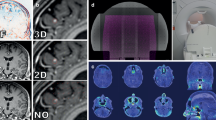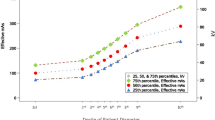Abstract
Purpose
To evaluate intra-fractional uncertainties during intensity-modulated radiotherapy (IMRT) of prostate cancer.
Patients and Methods
During IMRT of 21 consecutive patients, kilovolt (kV) cone-beam computed tomography (CBCT) images were acquired prior to and immediately after treatment: a total of 252 treatment fractions with 504 CBCT studies were basis of this analysis. The prostate position in anterior-posterior (AP) direction was determined using contour matching; patient set-up based on the pelvic bony anatomy was evaluated using automatic image registration. Internal variability of the prostate position was the difference between absolute prostate and patient position errors. Intra-fractional changes of prostate position, patient position, rectal distension in AP direction and bladder volume were analyzed.
Results
With a median treatment time of 16 min, intra-fractional drifts of the prostate were > 5 mm in 12% of all fractions and a margin of 6 mm was calculated for compensation of this uncertainty. Mobility of the prostate was independent from the bony anatomy with poor correlation between absolute prostate motion and motion of the bony anatomy (R2 = 0.24). A systematic increase of bladder filling by 41 ccm on average was observed; however, these changes did not influence the prostate position. Small variations of the prostate position occurred independently from intra-fractional changes of the rectal distension; a weak correlation between large internal prostate motion and changes of the rectal volume was observed (R2 = 0.55).
Conclusion
Clinically significant intra-fractional changes of the prostate position were observed and margins of 6 mm were calculated for this intra-fractional uncertainty. Repeated or continuous verification of the prostate position may allow further margin reduction.
Zusammenfassung
Ziel
Ziel der Arbeit war die Analyse von intrafraktionellen Fehlern in der intensitätsmodulierten Strahlentherapie (IMRT) des Prostatakarzinoms.
Patienten und Methodik
Bei 21 Patienten wurde vor und nach der IMRT-Behandlung ein Kilovolt-Cone-Beam-CT (kV CBCT) aufgenommen. Basierend auf 252 Behandlungsfraktionen und 504 CBCT-Studien wurde die Position der Prostata in anterior-posteriorer (AP) Richtung mittels manueller Konturregistrierung und die Lagerung des Patienten durch automatische Registrierung des Beckenskeletts ermittelt. Die interne Lagevariabilität der Prostata war definiert als die Differenz der Positionsfehler bezüglich Prostata und knöcherner Anatomie. Intrafraktionelle Veränderungen wurden für die Position der Prostata und des Patienten, die Füllung der Blase und die AP-Weite des Rektums bestimmt.
Ergebnisse
Bei einer medianen Behandlungszeit von 16 min waren intrafraktionelle Veränderungen der Prostataposition in 12% der Fraktionen > 5 mm; ein Sicherheitssaum von 6 mm wurde zur Kompensation berechnet. Die Beweglichkeit der Prostata war im Wesentlichen unabhängig von dem pelvinen Knochenskelett (R2 = 0,24). Eine systematische Zunahme des Blasenvolumens um durchschnittlich 41 ccm wurde während der Behandlung gemessen; dies hatte aber keinen Einfluss auf die AP-Position der Prostata. Während kleine Bewegungen der Prostata unabhängig von Änderungen der Rektumweite waren, wurde für interne Prostatabewegungen > 5 mm eine Korrelation (R2 = 0,55) mit intrafraktionellen Änderungen der Rektumweite beobachtet.
Schlussfolgerung
Intrafraktionelle Änderungen der Prostataposition waren von klinisch relevantem Ausmaß und benötigen einen Sicherheitssaum von 6 mm. Die kontinuierliche oder wiederholte Verifikation der Prostataposition könnte eine weitere Verkleinerung der Sicherheitssäume ermöglichen.
Similar content being viewed by others
References
Beltran C, Herman MG, Davis BJ. Planning target margin calculations for prostate radiotherapy based on intrafraction and interfraction motion using four localization methods. Int J Radiat Oncol Biol Phys 2008;70:289–295.
Cahlon O, Zelefsky MJ, Shippy A, et al. Ultra-High Dose (86.4 Gy) IMRT for Localized Prostate Cancer: Toxicity and Biochemical Outcomes. Int J Radiat Oncol Biol Phys 2007; 71:330–337.
de Boer HC, van Os MJ, Jansen PP, et al. Application of the No Action Level (NAL) protocol to correct for prostate motion based on electronic portal imaging of implanted markers. Int J Radiat Oncol Biol Phys 2005;61:969–983.
de Crevoisier R, Kuban D, Lefkopoulos D. [Image-guided radiotherapy by in-room CT-linear accelerator combination]. Cancer Radiother 2006;10:245–251.
de Crevoisier R, Tucker SL, Dong L, et al. Increased risk of biochemical and local failure in patients with distended rectum on the planning CT for prostate cancer radiotherapy. Int J Radiat Oncol Biol Phys 2005;62:965–973.
De Meerleer GO, Fonteyne VH, Vakaet L, et al. Intensity-modulated radiation therapy for prostate cancer: late morbidity and results on biochemical control. Radiother Oncol 2007;82:160–166.
De Meerleer GO, Vakaet LA, De Gersem WR, et al. Radiotherapy of prostate cancer with or without intensity modulated beams: a planning comparison. Int J Radiat Oncol Biol Phys 2000;47:639–648.
Dobler B, Mai S, Ross C, et al. Evaluation of possible prostate displacement induced by pressure applied during transabdominal ultrasound image acquisition. Strahlenther Onkol 2006;182:240–246.
Elsayed H, Bolling T, Moustakis C, et al. Organ movements and dose exposures in teletherapy of prostate cancer using a rectal balloon. Strahlenther Onkol 2007;183:617–624.
Fiorino C, Foppiano F, Franzone P, et al. Rectal and bladder motion during conformal radiotherapy after radical prostatectomy. Radiother Oncol 2005;74:187–195.
Ghilezan MJ, Jaffray DA, Siewerdsen JH, et al. Prostate gland motion assessed with cine-magnetic resonance imaging (cine-MRI). Int J Radiat Oncol Biol Phys 2005;62:406–417.
Guckenberger M, Baier K, Richter A, et al. Does Intensity Modulated Radiation Therapy (IMRT) prevent additional toxicity of treating the pelvic lymph nodes compared to treatment of the prostate only? Radiat Oncol 2008;3:3.
Guckenberger M, Flentje M. Intensity-Modulated Radiotherapy (IMRT) of localized prostate cancer: a review and future perspectives. Strahlenther Onkol 2007;183:52–62.
Guckenberger M, Meyer J, Wilbert J, et al. Precision of Image-Guided Radiotherapy (IGRT) in six degrees of freedom and limitations in clinical practice. Strahlenther Onkol 2007;183: 307–313.
Guckenberger M, Pohl F, Baier K, et al. Influence of rectum delineation (rectal volume vs. rectal wall) on IMRT treatment planning of the prostate. Strahlenther Onkol 2006;182:721–726.
Heemsbergen WD, Hoogeman MS, Witte MG, et al. Increased risk of biochemical and clinical failure for prostate patients with a large rectum at radiotherapy planning: results from the Dutch trial of 68 GY versus 78 Gy. Int J Radiat Oncol Biol Phys 2007;67:1418–1424.
Huang E, Dong L, Chandra A, et al. Intrafraction prostate motion during IMRT for prostate cancer. Int J Radiat Oncol Biol Phys 2002;53:261–268.
Kotte AN, Hofman P, Lagendijk JJ, et al. Intrafraction motion of the prostate during external-beam radiation therapy: analysis of 427 patients with implanted fiducial markers. Int J Radiat Oncol Biol Phys 2007;69:419–425.
Kupelian P, Willoughby T, Mahadevan A, et al. Multi-institutional clinical experience with the Calypso System in localization and continuous, real-time monitoring of the prostate gland during external radiotherapy. Int J Radiat Oncol Biol Phys 2007;67:1088–1098.
Kupelian PA, Thakkar VV, Khuntia D, et al. Hypofractionated intensity-modulated radiotherapy (70 gy at 2.5 Gy per fraction) for localized prostate cancer: long-term outcomes. Int J Radiat Oncol Biol Phys 2005;63:1463–1468.
Lee WR, Hanks GE, Hanlon AL, et al. Lateral rectal shielding reduces late rectal morbidity following high dose three-dimensional conformal radiation therapy for clinically localized prostate cancer: further evidence for a significant dose effect. Int J Radiat Oncol Biol Phys 1996;35:251–257.
Leibel SA, Hanks GE, Kramer S. Patterns of care outcome studies: results of the national practice in adenocarcinoma of the prostate. Int J Radiat Oncol Biol Phys 1984;10:401–409.
Ling CC, Burman C, Chui CS, et al. Conformal radiation treatment of prostate cancer using inversely-planned intensity-modulated photon beams produced with dynamic multileaf collimation. Int J Radiat Oncol Biol Phys 1996;35:721–730.
Mah D, Freedman G, Milestone B, et al. Measurement of intrafractional prostate motion using magnetic resonance imaging. Int J Radiat Oncol Biol Phys 2002;54:568–575.
Morin O, Gillis A, Chen J, et al. Megavoltage cone-beam CT: system description and clinical applications. Med Dosim 2006;31:51–61.
Moseley DJ, White EA, Wiltshire KL, et al. Comparison of localization performance with implanted fiducial markers and cone-beam computed tomography for on-line image-guided radiotherapy of the prostate. Int J Radiat Oncol Biol Phys 2007;67:942–953.
Nijkamp J, Pos FJ, Nuver TT, et al. Adaptive Radiotherapy for Prostate Cancer Using Kilovoltage Cone-Beam Computed Tomography: First Clinical Results. Int J Radiat Oncol Biol Phys 2008;70:75–82.
Padhani AR, Khoo VS, Suckling J, et al. Evaluating the effect of rectal distension and rectal movement on prostate gland position using cine MRI. Int J Radiat Oncol Biol Phys 1999;44:525–533.
Peeters ST, Heemsbergen WD, Koper PC, et al. Dose-response in radiotherapy for localized prostate cancer: results of the Dutch multicenter randomized phase III trial comparing 68 Gy of radiotherapy with 78 Gy. J Clin Oncol 2006;24:1990–1996.
Pinkawa M, Asadpour B, Gagel B, et al. Prostate position variability and dose-volume histograms in radiotherapy for prostate cancer with full and empty bladder. Int J Radiat Oncol Biol Phys 2006;64:856–861.
Pirzkall A, Carol M, Lohr F, et al. Comparison of intensity-modulated radiotherapy with conventional conformal radiotherapy for complex-shaped tumors. Int J Radiat Oncol Biol Phys 2000;48:1371–1380.
Pollack A, Zagars GK, Starkschall G, et al. Prostate cancer radiation dose response: results of the M. D. Anderson phase III randomized trial. Int J Radiat Oncol Biol Phys 2002;53:1097–1105.
Roach M, 3rd, DeSilvio M, Lawton C, et al. Phase III trial comparing whole-pelvic versus prostate-only radiotherapy and neoadjuvant versus adjuvant combined androgen suppression: Radiation Therapy Oncology Group 9413. J Clin Oncol 2003;21:1904–1911.
Simforoosh N, Dadkhah F, Hosseini SY, et al. Accuracy of residual urine measurement in men: comparison between real-time ultrasonography and catheterization. J Urol 1997;158:59–61.
Soete G, Van de Steene J, Verellen D, et al. Initial clinical experience with infrared-reflecting skin markers in the positioning of patients treated by conformal radiotherapy for prostate cancer. Int J Radiat Oncol Biol Phys 2002;52:694–698.
van Herk M. Errors and margins in radiotherapy. Semin Radiat Oncol 2004;14:52–64.
Wertz H, Lohr F, Dobler B, et al. [Dosimetric impact of image-guided translational isocenter correction for 3-D conformal radiotherapy of the prostate]. Strahlenther Onkol 2007;183:203–210.
Wu Q, Ivaldi G, Liang J, et al. Geometric and dosimetric evaluations of an online image-guidance strategy for 3D-CRT of prostate cancer. Int J Radiat Oncol Biol Phys 2006;64:1596–1609.
Zelefsky MJ, Crean D, Mageras GS, et al. Quantification and predictors of prostate position variability in 50 patients evaluated with multiple CT scans during conformal radiotherapy. Radiother Oncol 1999;50:225–234.
Zietman AL, DeSilvio ML, Slater JD, et al. Comparison of conventional-dose vs high-dose conformal radiation therapy in clinically localized adenocarcinoma of the prostate: a randomized controlled trial. Jama 2005;294:1233–1239.
Author information
Authors and Affiliations
Corresponding author
Rights and permissions
About this article
Cite this article
Polat, B., Guenther, I., Wilbert, J. et al. Intra-fractional uncertainties in image-guided intensity-modulated radiotherapy (IMRT) of prostate cancer. Strahlenther Onkol 184, 668–673 (2008). https://doi.org/10.1007/s00066-008-1875-6
Received:
Accepted:
Published:
Issue Date:
DOI: https://doi.org/10.1007/s00066-008-1875-6




